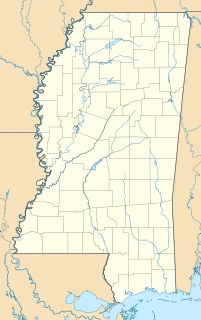 W
WAmory's Tribute to the Heroes of 1861–1865 is a Confederate monument in Amory, Mississippi. It was erected in 1924 by the local chapter of the United Daughters of the Confederacy.
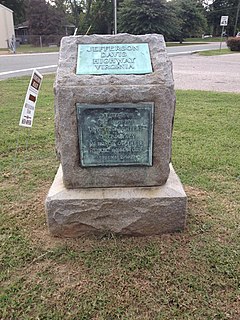 W
WThe Jefferson Davis Highway Marker is a commemorative marker on the Jefferson Davis Highway, in Hanover County, Virginia, near Ashland. It is a 42-inch-high (1.1 m) gray granite stone, with a slanted top, with two bronze plaques. The Jefferson Davis Highway was conceived and marked by the United Daughters of the Confederacy, as a counter to the Lincoln Highway in the north, during 1913–1925. In that era, named highways were being marked as automobile travel increased, and the advent of numbered highways eventually loomed. The marker was placed at the junction of what is now US Route 1 and Cedar Lane, between Richmond and Ashland, in 1927. It has been moved twice: in the 1970s it was moved to accommodate the widening of Route 1, and it was moved across Route 1 in the 1980s.
 W
WThe Brook Road Marker, Jefferson Davis Highway is a commemorative marker on the Jefferson Davis Highway, in Henrico County, Virginia, outside of Richmond, Virginia. The Jefferson Davis Highway was conceived and marked by the United Daughters of the Confederacy, as a counter to the Lincoln Highway in the north, during 1913–1925. In that era, named highways were being marked as automobile travel increased, and the advent of numbered highways eventually loomed. The marker was placed in North Richmond Brook Road, south of Hilliard Road, in 1927. It is one of the earliest, out of 16, that were placed to mark the highway in Virginia by the United Daughters of the Confederacy. It is a 42-inch-high (1.1 m) gray granite stone, with a slanted top, and a bronze plaque.
 W
WThe Camp Beauregard Memorial, outside Water Valley, Kentucky on Kentucky state road 2422 northeast of town, marks the site of a Confederate States Army encampment named for General P. G. T. Beauregard. The camp was situated to protect the right flank of the Confederate encampment at Columbus, Kentucky.
 W
WConfederate Defenders of Charleston is a monument in Charleston, South Carolina, United States. The monument honors Confederate soldiers from Charleston, most notably those who served at Fort Sumter during the American Civil War. Built with funds provided by a local philanthropist, the monument was designed by Hermon Atkins MacNeil and was dedicated in White Point Garden in 1932. The monument, standing 17 feet (5.2 m) tall, features two bronze statues of a sword and shield-bearing defender standing in front of a symbolic representation of the city of Charleston. In recent years, the monument has been the subject of vandalism and calls for removal as part of a larger series of removal of Confederate monuments and memorials in the United States.
 W
WThe Confederate Memorial Fountain was a historic fountain in Helena, Montana, and one of the very few monuments to The Confederacy located in the Northwestern United States. Erected in Hill Park in 1916, the fountain was removed in 2017. It was replaced by a new fountain, called the Equity Fountain, in 2020.
 W
WThe Confederate Memorial Fountain in Hopkinsville, Kentucky is a monument dedicated in October 1911. It is on the National Register of Historic Places.
 W
WThe Confederate Memorial Gates in Mayfield are historical monuments at the entrances to Maplewood Cemetery in Mayfield, Kentucky. The monuments were the second monument in Mayfield established by the United Daughters of the Confederacy; the first being the Confederate Memorial in Mayfield in downtown Mayfield. The gates were the third choice for monuments, chosen mostly due to their relatively low cost. The UDC intended them to not only be a monument to the residents of Graves County who served the Confederate States of America, but also a civic improvement.
 W
WThe Confederate Memorial Gateway in Hickman, Kentucky is a historic cemetery gateway in Fulton County, Kentucky. It was funded in 1913 by the Private Robert Tyler Chapter of the United Daughters of the Confederacy. It was placed on the National Register of Historic Places in 1997.
 W
WMemorial Hall is a historic building on the Peabody College campus of Vanderbilt University in Nashville, Tennessee. It was built in 1935 as a dormitory hall for female descendants of Confederate States Army veterans. Its former name resulted in multiple lawsuits and student unrest. In August 2016, Vanderbilt announced it would reimburse the United Daughters of the Confederacy for their financial contribution and remove the word Confederate from the building.
 W
WThe Confederate Memorial includes a 6-foot-tall (1.8 m) Confederate soldier statue atop an arch anchored in the Fulton, Kentucky Fairview Cemetery. Funded in 1902 by the Colonel Ed Crossland Chapter No. 347 of the United Daughters of the Confederacy, the historic monument is the only such monument in Kentucky to feature an arched base, made of rough-hewn limestone.
 W
WThe Confederate Memorial in Mayfield is a commemorative monument and fountain located on the courthouse lawn in downtown Mayfield, Kentucky.
 W
WThe War Memorial Museum is located at 1101–1199 Milam Street in Columbus, Texas. It is housed in an unusual building constructed in 1883: the ground floor of the town's water tower, which formerly housed its Fire Station. When the town's water system was modernized in 1926 and the water tower was no longer needed, the water tank was removed, but the building, with three foot brick walls, was so solid that dynamite, to demolish it, had no effect. It was then put up for sale. The United Daughters of the Confederacy (UDC) purchased it and used it as a meeting place. The Museum, which the UDC curates, opened in 1962.
 W
WThe Confederate Monument, in Cadiz, Kentucky, was placed on the National Register of Historic Places in 1997. A marble memorial to the Confederate veterans of Trigg County it was erected in 1913 by the United Daughters of the Confederacy.
 W
WThe Confederate Monument, also known as Chip, or Our Confederate Soldiers, is located on the grounds of the Williamson County Courthouse in the county seat - Franklin, Tennessee, United States. Installed in 1899, it is an Italian marble statue portraying a single Confederate soldier atop a tall column and base. The Battle of Franklin took place here during the American Civil War, and was won by the Union.
 W
WThe Confederate Monument in Lawrenceburg, Kentucky is an 8-foot-tall (2.4 m) carved granite figure on a granite pedestal which was built in 1894 by the Kentucky Women's Monumental Association, a predecessor of the United Daughters of the Confederacy, an organization founded in that year. Its governing body is the government of Lawrenceburg.
 W
WThe Confederate Monument in Owensboro, Ky. is a bronze sculpture on a granite pedestal, located at the southwest corner of the Daviess County Courthouse lawn in Owensboro, Kentucky.
 W
WThe Confederate Monument in Paducah, located northwest of downtown Paducah, Kentucky is a historic monument located in Paducah's Oak Grove Cemetery.
 W
WThe Confederate Memorial is a memorial in Arlington National Cemetery in Arlington County, Virginia, in the United States, that commemorates members of the armed forces of the Confederate States of America who died during the American Civil War. Authorized in March 1906, former Confederate soldier and sculptor Moses Jacob Ezekiel was commissioned by the United Daughters of the Confederacy in November 1910 to design the memorial. It was unveiled by President Woodrow Wilson on June 4, 1914.
 W
WThe Confederate Mothers Monument, also known as simply Confederate Memorial, Confederate Monument, or Texarkana Confederate Memorial, is an outdoor Confederate memorial installed at 500 State Line Road in Texarkana. It stands alone in a triangle bounded by roads on the West side of State Line Avenue, just inside the U.S. state of Texas. and faces the court house and post office, a building unusual for sitting in and serving two states.
 W
WConfederate Park is a park in Greenville, Alabama. The park was established in 1902 in front of the First Methodist Church on 1 acre of land donated by the church to the United Daughters of the Confederacy. The following year, the UDC commissioned a 16-foot (4.8-m) marble statue of a Confederate soldier on a pedestal. In the following years, many shrubs and shade trees were planted, and in 1909 a fountain was donated by Mayor Claude E. Hamilton, and was placed in the center of the park. Sidewalks along Commerce Street and diagonal walkways through the park, as well as several benches, were also placed. In the 1920s, a landscape architect was hired to place flowers and evergreens. In 1937, the city hall was built across Commerce Street from the park.
 W
WThe Confederate Soldier Monument in Caldwell County, Kentucky is a historic statue located on the Caldwell County Courthouse south lawn in the county seat of Princeton, Kentucky, United States. It was erected in 1912 by the Tom Johnson Chapter No. 886 of the United Daughters of the Confederacy (UDC).
 W
WThe Confederate War Memorial is a memorial to Confederate soldiers located behind the Common Pleas Courthouse in Cape Girardeau, Missouri. It was erected by the Cape Girardeau United Daughters of the Confederacy in 1931. It was moved to its current location in 1995. Beside it is a fountain and statue erected in 1911 by the Women's Relief Corps. This latter Union monument is dedicated "[i]n memory of the soldiers of the Civil War."
 W
WThe Confederate War Memorial is a 65 foot (20 m)-high monument that pays tribute to soldiers and sailors from Texas who served with the Confederate States of America (CSA) during the American Civil War. The monument was dedicated in 1897, following the laying of its cornerstone the previous year. Originally located in Sullivan Park near downtown Dallas, Texas, United States, the monument was relocated in 1961 to the nearby Pioneer Park Cemetery in the Convention Center District, next to the Dallas Convention Center and Pioneer Plaza.
 W
WDemopolis Town Square, currently officially known as Confederate Park, is a historic park in the city of Demopolis, Alabama, United States. It is one of the oldest public squares in the state. Demopolis had its beginnings in 1817 with the Vine and Olive Colony, and the park was established in 1819. The park covers one city block, bounded by Main, Capitol, Walnut, and Washington Streets.
 W
WFalling Creek UDC Jefferson Davis Highway Marker is a historic stone highway marker located near Richmond, in Chesterfield County, Virginia. It was erected in 1933, and is one of sixteen erected by the United Daughters of the Confederacy in Virginia along the Jefferson Davis Highway between 1927 and 1946. The marker is a gray granite boulder with rough-cut edges. The stone is engraved with the text “ERECTED BY THE FIRST DISTRICT VIRGINIA DIVISION UNITED DAUGHTERS OF THE CONFEDERACY 1933.” It is located in a wayside established in 1934, that provides access to the Bridge at Falling Creek. It was the first highway wayside park in Virginia.
 W
WElliott Grays Marker-Jefferson Davis Highway is a historic route marker located on U.S. Route 1, or Jefferson Davis Highway, in Richmond, Virginia. It was erected in 1929, by the United Daughters of the Confederacy. It is one of 16 erected in Virginia along the Jefferson Davis Highway between 1927 and 1947. The marker is an inscribed granite slab with smooth flat faces and rough-cut edges. It measures 47 inches tall, 25 inches wide and 12 inches thick. The stone is engraved with the text "Jefferson Davis Highway This tree marks the site of Battery 17 of the inner defenses of Richmond, 1862-65, and is planted in soil taken from battlefields A memorial to Confederate Soldiers by the Elliott Grays Chapter U.D.C. 1929."
 W
WThe Jefferson County Courthouse is a historic building in Charles Town, West Virginia, USA. The building is historically notable as the site of two trials for treason: that of John Brown in 1859, and those of unionizing coal miners from Mingo County, West Virginia, a consequence of the Battle of Blair Mountain, whose trials were moved from the southern part of the state in 1922 as a result of a change of venue.
 W
WThe Jefferson Davis Highway, also known as the Jefferson Davis Memorial Highway, was a planned transcontinental highway in the United States in the 1910s and 1920s that began in Arlington, Virginia, and extended south and west to San Diego, California; it was named for Jefferson Davis, President of the Confederate States, United States senator, and Secretary of War. Because of unintended conflict between the National Auto Trail movement and the federal government, it is unclear whether it ever really existed in the complete form that its United Daughters of the Confederacy (UDC) founders originally intended.
 W
WThe John Hunt Morgan Memorial in Lexington, Kentucky, is a monument created during the Jim Crow era, as a tribute to Confederate General John Hunt Morgan, who was from Lexington and is buried in Lexington Cemetery. The monument was originally situated on the Courthouse Lawn at the junction of North Upper and East Main Street, but was moved to Lexington Cemetery in 2018.
 W
WMaury Street Marker, Jefferson Davis Highway is a historic route marker located on U.S. Route 1, or Jefferson Davis Highway, in Richmond, Virginia. It was erected in 1935, by the United Daughters of the Confederacy (UDC). It is one of 16 erected in Virginia along the Jefferson Davis Highway between 1927 and 1947. The marker is an inscribed granite slab with smooth flat faces and rough-cut edges. It measures 45 inches (110 cm) tall, 25 inches (64 cm) wide and 9 inches (23 cm) thick. The stone is engraved with the text "Jefferson Davis Highway Erected by Elliott Grays Chapter United Daughters of the Confederacy 1935".
 W
WThe Memorial to the Women of the Confederacy, also known as the U.D.C. Memorial Building, is a historic building located in Richmond, Virginia, that serves as the national headquarters of the United Daughters of the Confederacy. It was listed on the U.S. National Register of Historic Places in 2008. The building is open to the public on scheduled days.
 W
WThe North Carolina Monument is a North Carolina memorial of the American Civil War commemorating the 32 Carolina regiments in action at the Battle of Gettysburg. The monument is a public artwork by American sculptor Gutzon Borglum located on Seminary Ridge, West Confederate Avenue, in the Gettysburg National Military Park.
 W
WProctor Creek, Jefferson Davis Highway Marker is a historic stone highway marker located near Richmond, in Chesterfield County, Virginia. It was erected in 1931, and is one of sixteen erected by the United Daughters of the Confederacy in Virginia along the Jefferson Davis Highway between 1927 and 1946. The marker is a gray granite boulder with rough-cut edges. The stone is engraved with the text "ERECTED BY THE FIFTH DISTRICT VIRGINIA DIVISION UNITED DAUGHTERS OF THE CONFEDERACY 1931."
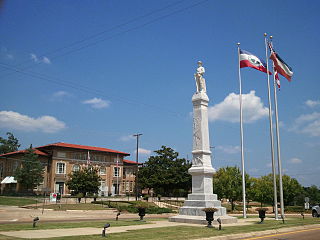 W
WThe Rankin County Confederate Monument is a war memorial located on the downtown square of Brandon, Mississippi, at the intersection of Government and North streets. The monument was erected in 1907 by the Brandon Chapter of the United Daughters of the Confederacy. The monument was listed on the National Register of Historic Places on August 1, 1997.
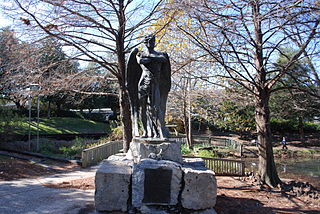 W
WSpirit of the Confederacy, also known as the Confederacy Monument, is an outdoor bronze sculpture depicting an angel holding a sword and palm branch by Louis Amateis, installed in Houston's Sam Houston Park, in the U.S. state of Texas. It was erected in 1908 by a local chapter of the United Daughters of the Confederacy. The statue was removed from the park in 2020 and relocated to the Houston Museum of African American Culture.
 W
WStone Mountain is a quartz monzonite dome monadnock and the site of Stone Mountain Park, 16 miles (26 km) east of Atlanta, Georgia. Outside the park is the small city of Stone Mountain, Georgia. The park is the most visited tourist site in the state of Georgia.
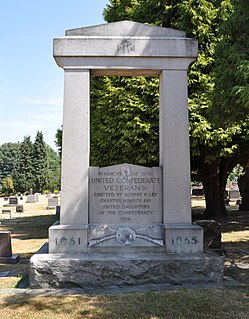 W
WThe United Confederate Veterans Memorial was a Confederate monument in Seattle's privately owned Lake View Cemetery, in the U.S. state of Washington. The memorial was erected by the United Daughters of the Confederacy in 1926. It was constructed of quartz monzonite from Stone Mountain, the Georgia landmark and birthplace of the modern Ku Klux Klan.